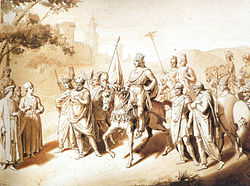Tigranes II.

Tigranes II the Great ( Armenian Տիգրան Մեծ / Tigran Metz , Greek Τιγράνης ; * around 140 BC ; † around 55 BC ), the son of Tigranes I and an Alan princess, was the most important king of the Artaxid dynasty and ruled from about 95 to 55 BC. Over Greater Armenia . In alliance with Mithridates VI. from Pontus he rose for a short time to the most powerful monarch in the eastern Mediterranean, but was then defeated by Rome and lost his numerous conquests again.
Hostage and first years as a king
After Armenia under his uncle Artavasdes I around 120 BC Had been attacked and defeated by the Great King Mithridates II (reigned 123-88 BC) of Parthia , Tigranes II had to live for many years in Parthian hostage at the court of Ctesiphon . Not until 96/95 BC After the death of his father Tigranes I, he was allowed to return to Artaxata - to ascend the throne - on the condition that he remained a friend of the Parthians and left them (according to Strabo ) "seventy valleys".
As the new king, Tigranes immediately began to expand his power: around 94 BC. He conquered Sophene and entered into an alliance with Mithridates VI. von Pontos , whose sixteen-year-old daughter Cleopatra he made his chief wife. In exchange for this marriage, Tigranes came in 93 BC. After the wish of his new father-in-law and let his army march into neighboring Cappadocia . Its king Ariobarzanes I , a Roman puppet, then fled and Tigranes made sure that with Ariarathes IX. - Mithridates' stepson, who had previously been expelled by the Roman general Sulla - as planned, the Pontic candidate ascended the throne in Mazaka before the Armenian troops withdrew to Artaxata with their booty and, above all, their prisoners.
Ascent to "King of Kings"
After the death of Mithridates II the Great (88 BC), Tigranes expanded his empire into Parthia: as far as Ekbatana in the land of the Medes , Arbela in Assyria and the Caspian Sea , he conquered the "seventy valleys" back as well as Mygdonia (with Nisibis ), Gordiene , Adiabene and Osrhoene in northern Mesopotamia and Atropatene in Azerbaijan .
Until 83 BC BC also subjugated the Shahan Shah , as Tigranes was now called, Syria (taking Antioch on the Orontes ), Phenicia , parts of Cilicia and Commagene , with which he broke the power of the Seleucid Empire and advanced to the Mediterranean . In consultation with Mithridates VI. Tigranes then fell around 77 BC. BC again in Cappadocia. He made around 300,000 prisoners, whom he deported as well as other peoples in order to settle them in his newly built capital Tigranokerta ("City of the Tigranes"), which is perhaps identical to Martyropolis .
War and defeat against Rome
Tigranes' splendid reign as great king did not last. After Mithridates VI. in the course of the 3rd Mithridatic War 71 BC Had fled to Armenia and Tigranes had refused to hand over his friend to Rome, he was from 69 BC. In the war against Rome and lost Tigranokerta and Nisibis to Lucullus despite the numerical superiority of his forces .
As Tigranes' son in 66 BC BC rebelled against his father and Pompey marched with a new army on Artaxata, Tigranes finally gave up and accepted the Roman offer of surrender. He lost all possessions with the exception of Armenia and ruled as a "friend of Rome" until his death . Artavasdes II was his successor .
literature
- Sirarpie Der Nersessian : The Armenians. London 1969.
- Mack Chahin: The Kingdom of Armenia. New York 1991.
- Adrienne Mayor: Pontic Poison. The legend of Mithridates, Rome's greatest enemy. Theiss, Stuttgart 2011, ISBN 978-3-8062-2428-3 .
- Hakob Manandyan: Tigranes II and Rome: A New Interpretation Based on Primary Sources. Translated by George A. Bournoutian. Mazda Publishers, Costa Mesa (CA) 2007.
- Theodor Mommsen : The situation of Tigranokerta. In: Hermes , Volume 9, 1874, pp. 129-149.
- VG Gurzadyan, R. Vardanyan: Halley's comet of 87 BC on the coins of Armenian king Tigranes? In: Astronomy & Geophysics , Volume 45, Number 4, August 2004, p. 4.06 ( online ).
- N. Garsoian: Tigran II . In: Ehsan Yarshater (Ed.): Encyclopædia Iranica , as of July 20, 2005, accessed on May 25, 2016 (English, including references)
Web links
Individual evidence
- ↑ Ruben Manaseryan: Տիգրան Մեծ ՝ Հայկական Պայքարը Հռոմի և Պարթևաստանի Դեմ, մ.թ.ա. 94-64 թթ. ( Tigran the Great: The Armenian Struggle Against Rome and Parthia, 94-64 BC ). Lusakan Publishing, Yerevan 2007.
- ↑ Ruben Manaseryan: Տիգրան Բ (Tigran II). In: Armenian Soviet Encyclopedia. Volume XI, Armenian Academy of Sciences , Yerevan 1985, pp. 697-698.
- ^ Strabo, Geography 11,14,15.
| predecessor | Office | successor |
|---|---|---|
| Tigranes I. |
King of Armenia around 95–55 BC Chr. |
Artavasdes II |
| Philip I and Antiochus XII. |
King of the Seleucid Empire 83–69 BC Chr. |
Antiochus XIII. |
| personal data | |
|---|---|
| SURNAME | Tigranes II. |
| ALTERNATIVE NAMES | Tigranes the Great; Tigranes I. |
| BRIEF DESCRIPTION | King of Armenia |
| DATE OF BIRTH | 2nd century BC Chr. |
| DATE OF DEATH | around 55 BC Chr. |


